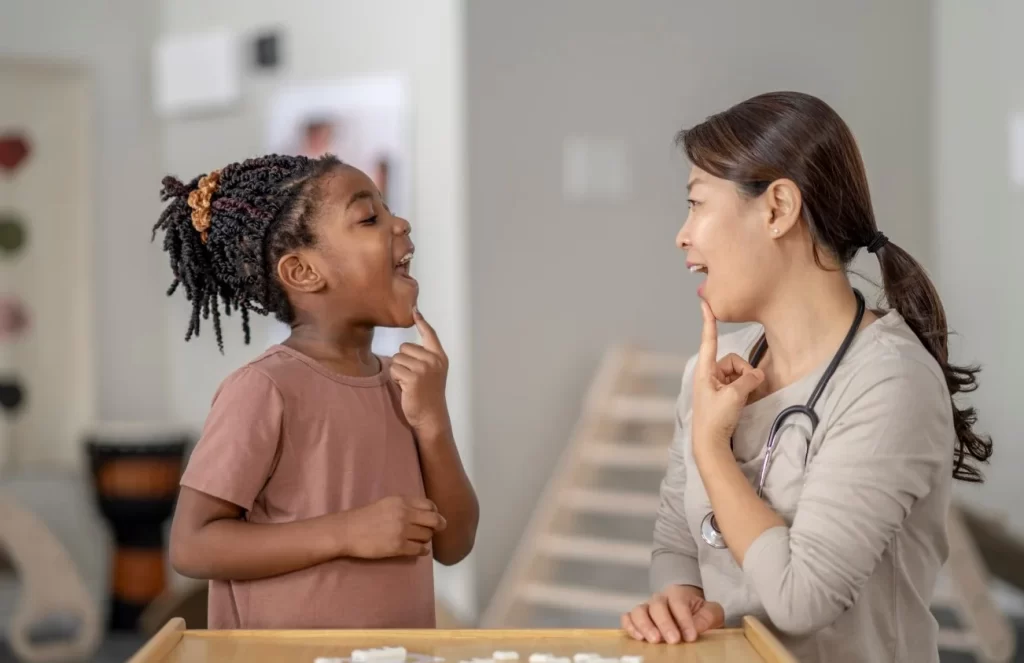Pediatric Speech Therapy — Techniques and Approaches
Communication is a key part of human development. It allows us to connect with others, express our needs and wants, and learn about the world around us. For children, developing strong communication skills is essential for success in school and in life. However, some children may have difficulty communicating, and that’s where pediatric speech therapy comes in. It can be a rewarding experience for both children and parents, helping children reach their full potential and live happy and fulfilling lives.
From helping toddlers find their first words to aiding children with speech and language disorders, the world of pediatric speech therapy is a vital resource for unlocking a child’s potential, fostering their self-expression, and ensuring a brighter future. This article delves into the techniques and approaches that make this discipline a cornerstone of early childhood development.
What Is Pediatric Speech Therapy?
Pediatric speech therapy is a specialized form of therapy designed to address communication and speech-related challenges in children. It focuses on diagnosing, treating, and helping children overcome a wide range of speech and language disorders, ensuring they can communicate effectively and reach their full potential.
Speech therapy for children is a multifaceted discipline that goes beyond merely teaching kids to articulate words correctly. It encompasses various techniques and strategies to enhance language skills, social communication, and overall oral development. The ultimate goal is to empower children with the tools they need to express themselves, understand others, and engage effectively with the world around them.
Pediatric speech therapy can be provided in a variety of settings, including schools, hospitals, clinics, and private homes. SLPs may work with children individually or in groups. They also collaborate with other healthcare professionals, such as doctors, nurses, and teachers, to provide comprehensive care for their patients.
What Is the Role of Speech Therapist?

A speech therapist, also known as a speech-language pathologist, plays a crucial role in helping children overcome speech and language disorders. Their responsibilities include:
- Evaluation: The therapist assesses a child’s speech and language skills, identifying any communication challenges or developmental delays.
- Diagnosis: Based on the evaluation, the speech therapist diagnoses the specific speech or language disorder the child is experiencing.
- Treatment Planning: The therapist creates a customized treatment plan tailored to the child’s unique needs and goals.
- Therapy Sessions: Through one-on-one or group therapy sessions, the therapist employs various techniques and exercises to improve the child’s communication skills.
- Progress Monitoring: Regular assessments are conducted to track the child’s progress and adjust the treatment plan as needed.
- Collaboration: Speech therapists often collaborate with other healthcare professionals, teachers, and parents to provide comprehensive care and support.
How to Find Out If Your Kids Need Speech Therapy?
Determining if your child requires speech therapy involves observing their communication and language development. Signs that may indicate the need for speech therapy include:
- Pronunciation Difficulties: If your child has persistent trouble pronouncing certain sounds or words, it may be a red flag.
- Limited Vocabulary: A limited vocabulary for their age can suggest language delays.
- Stuttering: Repetitive sounds, syllables, or words can indicate stuttering, which may benefit from therapy.
- Poor Comprehension: Difficulty understanding spoken language or following directions may point to language issues.
- Lack of Social Interaction: Struggles with engaging in conversations, making friends, or maintaining eye contact may signal communication challenges.
If you notice these Indications of Speech Therapy, consulting a paediatrician or a speech therapist for a professional evaluation is a wise first step. It is important to find a Speech Language Pathologist (SLP) that you and your child feel comfortable with. Speech therapy can be a long-term process, so it is important to find an SLP that you can trust and who you believe will be able to help your child reach their full potential.
What Kinds of Disorders Can Be Treated by a Speech Pathologist?

Speech pathologists are trained to address a wide range of speech and language disorders in children, including:
- Articulation Disorders: These involve difficulties in pronouncing sounds or forming words correctly.
- Language Disorders: Children with language disorders may have trouble with vocabulary, sentence structure, or understanding language.
- Fluency Disorders: Stuttering is a common fluency disorder that affects the flow of speech.
- Voice Disorders: These can manifest as hoarseness, pitch problems, or vocal cord issues.
- Social Communication Disorders: Conditions like autism can lead to social communication challenges that speech therapists can help manage.
- Feeding and Swallowing Disorders: Speech therapists can assist children with difficulties in eating, drinking, and swallowing.
- Auditory Processing Disorders: These disorders affect how children process and interpret auditory information, which can impact their language skills.
What Speech Therapy Techniques Are Used in Speech Therapy for Children?
Speech therapists employ a variety of techniques and strategies to address speech and language disorders in children. Some of these techniques include:
- Articulation Therapy: This Speech Delay Treatment focuses on correct pronunciation and speech sound production.
- Language Intervention: Enhancing vocabulary, sentence structure, and comprehension.
- Fluency Shaping: Reducing stuttering through controlled speech techniques.
- Voice Therapy: Addressing voice quality and pitch issues.
- Play-Based Therapy: Using play activities to improve communication skills in young children.
- Augmentative and Alternative Communication (AAC): Implementing communication devices and systems for non-verbal or minimally verbal children.
- Orofacial Myofunctional Therapy: Addressing issues with tongue and facial muscle function that affect speech.
- Speech Physiotherapy: Speech Physiotherapy is a holistic approach to treating speech and language disorders that focuses on the physical and neurological aspects of communication. It is often used to treat children with dysarthria, cerebral palsy, and other neurological conditions that affect the muscles and nerves used for speech.
These techniques are tailored to each child’s specific needs and may involve a combination of approaches to achieve the best results. Speech therapy for babies and toddlers focuses on nurturing early communication skills, helping them build a strong foundation for effective language development.
Types of Pediatric Speech Therapy and Their Benefits
There are several Types of Speech Therapy for Kids, each with its unique focus and benefit. Some of the most common types and Benefits of Speech Therapy include:
- Articulation Therapy: This type of therapy targets sound production and pronunciation, helping children overcome difficulties with specific speech sounds. The benefits include improved speech clarity and increased self-confidence.
- Language Therapy: Language therapy focuses on developing vocabulary, sentence structure, and understanding of language. It can enhance a child’s ability to express thoughts and comprehend spoken and written language.
- Fluency Therapy: Children with stuttering issues benefit from fluency therapy, which aims to improve speech flow and reduce stuttering episodes. The benefits include increased fluency and reduced social anxiety.
- Voice Therapy: Voice therapy is designed to address voice quality, pitch, and resonance problems. It can help children develop a more pleasant and effective speaking voice.
- Social Communication Therapy: This therapy is essential for children with autism or other social communication disorders. It helps improve social interaction, conversational skills, and understanding of non-verbal cues.
- Feeding and Swallowing Therapy: For children with feeding and swallowing difficulties, this therapy focuses on improving safe and efficient eating and drinking. It can prevent choking and aspiration.
- AAC (Augmentative and Alternative Communication): AAC therapy involves the use of communication devices, picture communication boards, or sign language to help non-verbal or minimally verbal children express themselves.
Each type of therapy serves a specific purpose, and speech therapists customize their approach based on the child’s diagnosis and individual needs. The ultimate goal is to empower children with the tools they need to communicate effectively, thereby improving their overall quality of life.
FAQs
The best age for speech therapy varies, but early intervention is crucial. Most children can start as young as 18 months if there are speech concerns. However, therapy can benefit individuals of all ages.
Effective speech therapy activities for toddlers include reading, singing, playing games, and encouraging communication through fun and interactive methods.
Speech therapy can be highly beneficial for differently-abled children by improving communication skills, enhancing social interactions, and addressing specific challenges related to their condition.
Speech therapy can be very successful, but its effectiveness depends on various factors, including the individual’s dedication, the therapist’s expertise, and the nature of the speech disorder.
Yes, speech therapists often teach phonics as part of their work, especially for children and individuals with reading and pronunciation difficulties. Phonics helps improve language and reading skills.

